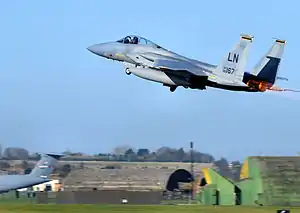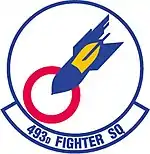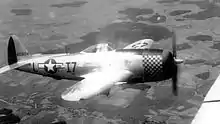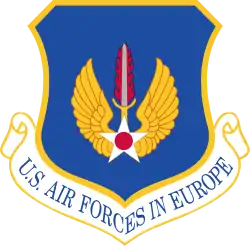493rd Fighter Squadron
The 493d Fighter Squadron, nicknamed "The Grim Reapers", is part of the United States Air Force's 48th Fighter Wing located at RAF Lakenheath, England. The 493d is currently the only USAF squadron flying the McDonnell Douglas F-15C/D Eagle within United States Air Forces Europe and has been flying the F-15C since 1994. These 493d F-15C fighter aircraft have weaponry systems specifically designed to locate and target enemy aircraft and include the AIM-9 and AIM-120 air-to-air missiles. The 493d provides air-to-air offensive and defensive support for United States and NATO operations. The squadron has earned multiple commendations and awards, including the Air Force Association's Hughes Trophy in 1997 and 1999[4] and the 2007 and 2014 Raytheon Trophies, for being recognized as the top fighter squadron in the United States Air Force.
| 493d Fighter Squadron | |
|---|---|
 493d Fighter Squadron F-15C Eagle[note 1] | |
| Active | 15 Jan 1941 – 7 Nov 1945 10 July 1952 – 18 Dec 1992 1 Jan 1994 – present |
| Country | |
| Branch | |
| Role | Fighter |
| Part of | United States Air Forces in Europe |
| Garrison/HQ | RAF Lakenheath |
| Nickname(s) | The Grim Reapers[1] |
| Motto(s) | Latin: Mors Inimicus ("Death to the Enemy") |
| Colors | Black/Gold |
| Engagements | European Theater of Operations War in Kosovo Global War on Terror[2] |
| Decorations | Distinguished Unit Citation Navy Meritorious Unit Commendation Air Force Outstanding Unit Award Belgian Fourragère[2] |
| Commanders | |
| Current commander | Lt Col Mark Perry |
| Insignia | |
| 493d Fighter Squadron emblem (approved 20 August 2003)[2] |  |
| 493d Tactical Fighter Squadron emblem |  |
| 56th Bombardment Squadron emblem (approved 24 December 1941)[3] |  |
| Squadron tail codes | LS (Mar 1970 – Dec 1971) LR (Dec 1971 – July 1972) LN (July 1972 – present) |
Mission
The 493d is a combat-ready F-15 Eagle squadron capable of executing air superiority and air defense missions in support of United States Air Forces in Europe, United States European Command, and NATO operations. It employs air-to-air weapons and electronic identification systems. The squadron has the ability to rapidly generate, deploy, and sustain operations to execute wartime and peacetime taskings in any theater of operations in the world.[5] Furthermore, the 493d is routinely tasked to deploy in support of Air Force One referred to as "POTUS taskings." Recent instances include the most recent G-8 summits and the 2008 NATO Summit.
History
World War II
Activated as a Southeastern Air District Army Air Corps training squadron, equipped with a variety of second-line aircraft, both single and twin engine, preparing its pilots and maintenance crews for eventual combat. After the Pearl Harbor Attack, the squadron flew antisubmarine patrols from March to April 1942. Resumed aircrew training, many of the group's members went on to serve in squadrons stationed in Europe and the Pacific theaters.

Eventually coming under the AAF III Fighter Command in 1944, trained replacement pilots with Republic P-47 Thunderbolts, Converted in January 1944 to an operational fighter squadron. Deployed to the European Theater of Operations, being assigned to the IX Fighter Command in England, March 1944.
Almost immediately after their arrival, the squadron began a rigorous training program, flying dive-bombing, glide bombing, night flying, low-level navigation, smoke laying, reconnaissance, and patrol convoy sorties. Over the next two months, the number of sorties steadily increased and the squadron flew its first combat mission on 20 April 1944, an uneventful fighter sweep of the occupied French coast.
Assisted the Normandy invasion by dropping bombs on bridges and gun positions, attacking rail lines and trains, and providing visual reconnaissance reports. Moved to France in mid-June 1944, supporting ground operations of Allied forces moving east across northern France throughout the war: primarily providing support for the United States First Army. Eventually was stationed in Occupied Germany on V-E Day.
On 5 July 1945, the squadron arrived in Laon, France. After a few weeks back in France the squadron received orders to return to the US. With many of the members separating at port, those remaining set up the headquarters at Seymour Johnson Field, North Carolina and was programmed for deployment to Okinawa to take part in planned Invasion of Japan. Training discontinued after Atomic bombings of Hiroshima and Nagasaki and the sudden end of the Pacific War.
Two months later on 7 November 1945, the squadron inactivated as part of the massive postwar draw down.
Cold War

The squadron was reactivated in 1952 as a NATO Fighter-Bomber squadron stationed in France. Equipped initially with Republic F-84G Thunderjets, upgraded in 1954 to North American F-86F Sabre aircraft. conducted operational readiness exercises and tactical evaluations. Honing bombing and gunnery skills, the squadron frequently deployed to Wheelus Air Base, Libya for training.

Then in late 1956 the squadron upgraded to the North American F-100D Super Sabre. However, the nuclear-weapon-capable F-100 caused disagreements with France concerning atomic storage and custody issues within NATO, resulting in a decision to remove Air Force atomic-capable units from French soil. On 15 January 1960, the squadron and its parent 48th Tactical Fighter Wing moved to RAF Lakenheath, UK.
Between 1960 and 1972, the squadron's F-100 fleet maintained its readiness by participating in a number of USAFE and NATO exercises training to react to possible aggression from the Soviet Union. They underwent a series of NATO tactical evaluations. The squadron conducted several deployments to Turkey, Italy, Spain, and across the United Kingdom.

Beginning in late 1971, the squadron started its conversion to the McDonnell F-4D Phantom II, with the aircraft being transferred from the 81st Tactical Fighter Wing at RAF Bentwaters. The conversion to the F-4D took several years, with the last F-100 departing in August 1974. With the arrival of the Phantoms, the F-4s adopted a common tail code of "LK". This tail code lasted only a few months as in July and August 1972 the 48th Wing further recoded to "LN".

The F-4's service with squadron was short as Operation Ready Switch transferred the F-4Ds to the 474th Tactical Fighter Wing at Nellis Air Force Base Nevada. The 474th sent their General Dynamics F-111As to the 347th Tactical Fighter Wing at Mountain Home Air Force Base, Idaho, and the 347th sent their F-111Fs to Lakenheath in early 1977. Unlike the previous F-4 transition, the F-111 change took place quickly and without any significant problems. Almost immediately after changing aircraft, the squadron began a series of monthly exercises and deployments that took the Liberty Wing to Italy, Iran, Greece, and Pakistan.
The 48th Wing also participated in Operation El Dorado Canyon, the air raid on Tripoli, Libya on 14 and 15 April 1986. It flew combat missions in Southwest Asia from January to February 1991 as part of Operation Desert Storm.
.jpg.webp)
Modern era
In the midst of the organizational changes, the squadron switched aircraft again, exchanging the F-111s for the F-15C/D Eagle in early February 1994. This marked the first time that the squadron had flown a specifically air-to-air weapon system, after flying for more than 50 years with an air-to-ground mission. The squadron received the last production block of new F-15 Eagles.
The squadron participated in Operation Odyssey Dawn in Libya in March 2011, along with numerous deployments to Southwest Asia supporting air expeditionary units as part of the ongoing Global War on Terrorism and as part of Operation Iraqi Freedom and Operation Enduring Freedom.[2]
In 2015, the squadron was named the best fighter squadron in the Air Force, earning the Raytheon Trophy for 2014. During tensions in the Ukraine that threatened stability in Eastern Europe, the 493d deployed to Lithuania in less than 20 hours, to supplement the Baltic air policing mission. The squadron intercepted 31 Russian air force aircraft when they threatened or violated Baltic airspace. This deployment came while the squadron was simultaneously supporting a deployment to Iceland. "The squadron 'adopted' an orphanage in Lithuania, with airmen visiting and caring for kids for four months. The Raytheon award was the fourth for the squadron.[6]
The squadron received the award yet again in 2016 and 2019 based on its operations those years, which included short-notice rapid deployments to the Middle East and multiple high-profile training exercises.
In 2016, the 493d deployed for about 190 days at various locations frequented by United States Air Force Europe (USAFE) command.
In early 2019, the squadron’s F-15Cs had just two weeks notice to deploy to the Middle East for Operation Inherent Resolve, to fill the air superiority role vacated by F-22s that returned home in an effort to increase the Raptor fleet’s readiness.
Lineage
- Constituted as the 56th Bombardment Squadron (Light) on 20 November 1940
- Activated on 15 January 1941
- Redesignated 56th Bombardment Squadron (Dive) on 28 August 1942
- Redesignated 493d Fighter-Bomber Squadron on 10 August 1943
- Redesignated 493d Fighter Squadron, Single Engine on 30 May 1944
- Inactivated on 7 November 1945
- Redesignated 493d Fighter-Bomber Squadron on 25 June 1952
- Activated on 10 July 1952
- Redesignated 493d Tactical Fighter Squadron on 8 July 1958
- Redesignated 493d Fighter Squadron on 1 October 1991
- Inactivated on 18 December 1992
- Activated on 1 January 1994[2]
Assignments
- 48th Bombardment Group (later 48th Fighter-Bomber Group, 48th Fighter Group), 15 January 1941 – 7 November 1945
- 48th Fighter-Bomber Group, 10 July 1952
- 48th Fighter-Bomber Wing (later 48th Tactical Fighter Wing, 48th Fighter Wing), 8 December 1957 – 18 December 1992
- Attached to 48th Fighter Wing (Provisional), 2 September 1990 – 15 March 1991; 7440th Composite Wing, September–December 1991
- 48th Operations Group, 1 January 1994 – present[2]
Stations
|
|
Aircraft
|
|
References
Notes
- Explanatory notes
- Aircraft is McDonnell Douglas F-15C-42-MC Eagle, serial 86-167 taking off in 2009.
- Aircraft is Republic P-47D-30-RA Thunderbolt, serial 44-33204.
- Both aircraft are Republic F-84G-1-RE Thunderjets. Serial 51-890 is from the 494th Fighter-Bomber Squadron and 51-830 is from the 493d. Note the Pierced Steel Planking used for the parking apron as concrete pads have not yet been poured. Both aircraft were eventually sold to the Belgian Air Force as Serials FZ-175 and FZ-199. FZ-175 was destroyed on 25 May 1955 at Sylt, West Germany.
- Aircraft is North American F-86F-25-NH Sabre, serial 52-5403.
- Aircraft is McDonnell F-4D-30-MC Phantom II, serial 66-7563.
- Aircraft is General Dynamics F-111F Aardvark, serial 72-449.
- The two green stars on the nose relate to a Mirage F1 and a MiG-23 which this Eagle shot down during 'Desert Storm' while operated by the 53rd TFS.
- Citations
- Bradley, Capt Kevin (19 June 2008). "493rd FS awarded Raytheon Trophy". U.S. Air Forces in Europe. Archived from the original on 16 June 2011. Retrieved 1 April 2010.
- Dollman, TSG David (21 October 2016). "Factsheet 493 Fighter Squadron (USAFE)". Air Force Historical Research Agency. Retrieved 24 November 2018.
- Maurer, Combat Squadrons, pp. 594-595
- No byline (7 May 2011). "493rd Fighter Squadron (493rd FS)". globalsecurity.org. Retrieved 24 November 2018.
- No byline (1 August 2013). "Factsheets: 48th Operations Group". 48th Fighter Wing Public Affairs. Archived from the original on 28 September 2015. Retrieved 24 November 2018.
- O'Shea, SRA Erin (29 January 2015). "Lakenheath's 493rd FS awarded 2014 Raytheon Trophy". 48th Fighter Wing Public Affairs. Retrieved 11 March 2016.
- Station number in Anderson.
- Station number in Johnson.
Bibliography
![]() This article incorporates public domain material from the Air Force Historical Research Agency website http://www.afhra.af.mil/.
This article incorporates public domain material from the Air Force Historical Research Agency website http://www.afhra.af.mil/.
- Anderson, Capt. Barry (1985). Army Air Forces Stations: A Guide to the Stations Where U.S. Army Air Forces Personnel Served in the United Kingdom During World War II (PDF). Maxwell AFB, AL: Research Division, USAF Historical Research Center. Archived from the original (PDF) on 23 January 2016. Retrieved 28 June 2017.
- Johnson, 1st Lt. David C. (1988). U.S. Army Air Forces Continental Airfields (ETO) D-Day to V-E Day (PDF). Maxwell AFB, AL: Research Division, USAF Historical Research Center. Archived from the original (PDF) on 29 September 2015. Retrieved 26 June 2017.
- Maurer, Maurer, ed. (1983) [1961]. Air Force Combat Units of World War II (PDF) (reprint ed.). Washington, DC: Office of Air Force History. ISBN 0-912799-02-1. LCCN 61060979.
- Maurer, Maurer, ed. (1982) [1969]. Combat Squadrons of the Air Force, World War II (PDF) (reprint ed.). Washington, DC: Office of Air Force History. ISBN 0-405-12194-6. LCCN 70605402. OCLC 72556.
- Ravenstein, Charles A. (1984). Air Force Combat Wings, Lineage & Honors Histories 1947-1977. Washington, DC: Office of Air Force History. ISBN 0-912799-12-9. Retrieved 17 December 2016.

